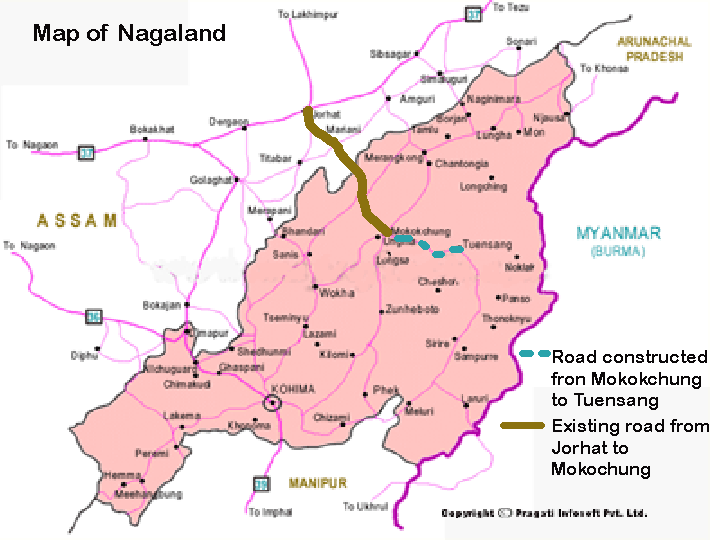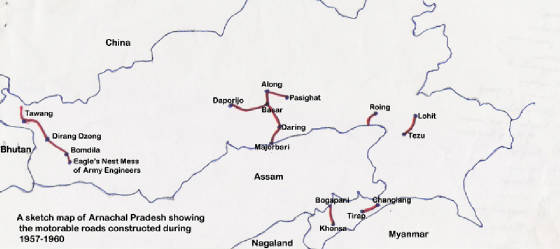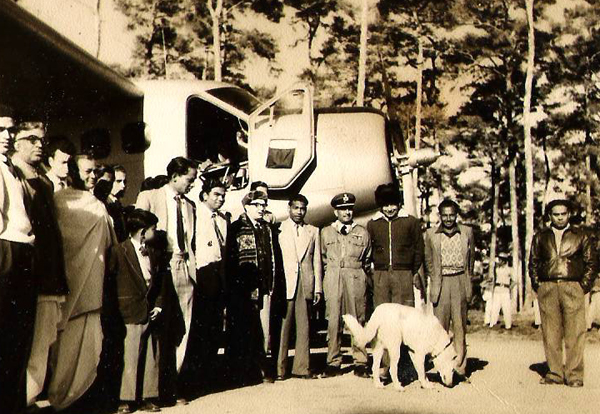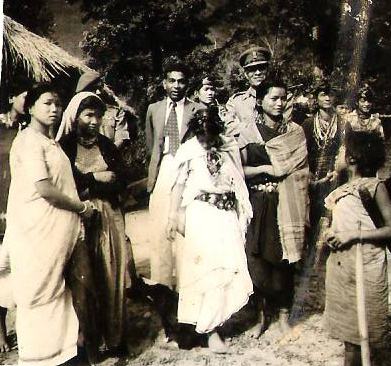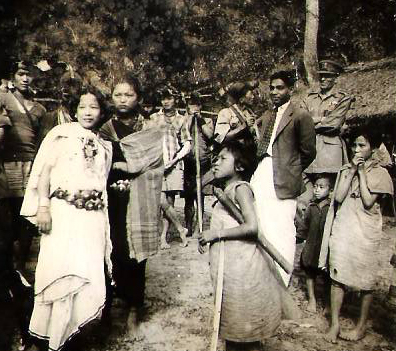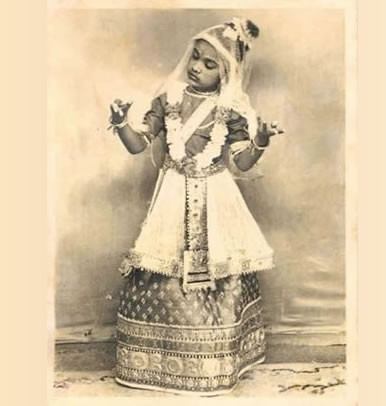|
Durai's Space |
|
Dangerous Mission
Sketch map of Nagaland showing the construction of motorable road from Mokokchung to Tuensang in 1957.
Nagaland was part of NEFA at that time.
Sketch map of Arunachal Pradesh showing the motorable roads constructed during my stay
First plane landing by Group Captain Lodhi at Upper Shillong Airfield constructed by me in 1959.
Welcome at one of the Apatani Tribal villages in NEFA in 1957 on my taking over charge.
I was entertained by the tribal people whenever I visited any of the tribal villages
On completion of the IIT work, I was posted back to Naga hostiles at Assam Some time in October 1956, the CPWD Superintending Engineer
posted at Shillong in charge of works of North East Frontier Agency (NEFA) was ambushed by the Naga hostiles but was fortunate
enough to escape with his life though a stenographer who was with him was killed. He became a nervous wreck and CPWD
wanted a replacement for him. NEFA came directly under the charge of the External Affairs Ministry with the Prime Minister,
Pandit Jawaharlal Nehru heading it. We came to know later that the Superintending Engineer had
been directed to construct a road from Mokokchung to Tuensang in Nagaland on high priority as without this important
road communication, the Army was finding it difficult to tackle the Naga hostiles who were then conducting a guerilla
type of warfare against the Government. The sanction for the road was given as early as 1952 but till 1956 no action
was taken by CPWD, even to survey and align the road. The Superintending Engineer was dead scared to go into Nagaland to survey
the road as the Naga hostilities were at their peak during that period and so the road construction remained unattended.
The General Officer Commanding (GOC) of that area was
extremely perturbed over this abnormal delay in constructing the road and he took up the matter with the Prime Minister who
directed the Engineer-in-Chief, CPWD to ensure that the construction of the road was taken up immediately and completed without
any further delay. The Engineer-in-Chief in turn asked the Superintending Engineer to proceed immediately to Nagaland and
ensure early completion of the work as directed by the Prime Minister. As he was nervous to go over to Nagaland all by himself,
he pleaded with the other Heads of Department to accompany him as he felt that this hazardous task was unnecessarily
being thrust upon him. Sympathising with his plight, the other Heads of Department obliged him by agreeing to go with
him. All these Army manoeuvres further frightened the Superintending
Engineer who became more and more nervous. The convoy reached at about 6 pm and the Superintending Engineer was put up in
a Circuit House with soldiers behind sand-bags guarding the Circuit House. He could not sleep the whole night and in
the morning, he spoke to the Political Officer of the Division who is of the rank of Dy. Collector and asked him to
arrange for a special convoy back to Jorhat as he was not prepared to stay any longer at Mokokchung. He said that he
was even prepared to resign from the Department if it became necessary. The Special Convoy left Mokokchung with the Superintending
Engineer getting into the 4th jeep instead of the 2nd jeep which was normally meant for the VIP. The
stenographer therefore occupied the 2nd jeep. The road from Mokukchung towards Jorhat winds around a bit and faces
Mokokchung once again after a four mile ride, separated only by a deep valley. While the Special Convoy was at that place,
there was shooting from the adjoining hill which killed the driver of the front Army vehicle. Before he died
he drove the vehicle on to the hill-side, otherwise it would have fallen down the velley on the left side, taking all
the troops with it. There was a second shot which killed the stenographer sitting in the 2nd
jeep. The Army retaliated and shot one of the Nagas while the second fellow ran away. It was found later that the
Naga who was killed was the same man who was at the marketplace listening to their conversation. The Superintending Engineer
became hysterical and took shelter under the jeep and started screaming while the Nepali peon stood on the side of the jeep
covering him. The Superintending Engineer became a nervous wreck after this and proceeded on long leave, thus creating
the vacancy. The Engineer-in-Chief sent circulars around to get Engineers
to volunteer for the post but in spite of so many circulars and pressure from the Prime Minister’s Secretariat there
was no response for almost 6 months. I felt this situation rather embarrassing and I went on my own accord to the
Engineer-in-Chief. I told him that the work in NEFA should either be handed over to the Army because of the hostile
law and order situation there or if this could not be done, I was prepared to volunteer to fill up the vacancy. He thought
at first that I was joking , as So all of us, that is Mabel and I, Malathi, Suresh,
Kamali, Poornam, our faithful maid and our cocker spaniel left by train to Gauhati in Assam in May 1957. From there we went
by road to Shillong, a pretty hill station, which was then the Head-Quarters of NEFA. A bungalow on 5 acres of land with 4 geese as watchmen My Departmental staff had arranged a large bungalow for me
on the hill, just below the residence of the Maharaja of Tripura, located on 5 acres of land with a stream running through
it. The house had 4 large bed rooms with large dressing rooms and toilets attached, a spacious kitchen, pantry and stores
and an outhouse with 4 rooms to accommodate the peon (office boy), m Cycle rides, pony rides and Manipuri dance Road from Mokukchung to Tuensang
I reported for duty to General Shrinagesh, Governor of Assam
and to Mr. K. L. Mehta, ICS, Adviser to the Governor of Assam. All the Heads of Departments were designated as Directors in
NEFA and I was designated as Director of Engineering. My first assignment was to construct the road from Mokukchung to Tuensang,
the capital of Nagaland which had remained unattended though sanctioned as early as 1952. Introducing a new concept: 'Single Line Administration' No more 100-vehicle convoys! As I mentioned earlier, I had to go through the same
drill of traveling from Jorhat to Mokokchung in a 100-vehicle convoy and being put up in the Circuit House with the
soldiers guarding us by stationing themselves around the building behind sandbags and on the alert, as I was told that the
hostiles become quite active whenever some VIP arrives. The next morning, I met the Political Officer and told him that I had come to construct the road so I could not just remain caged in the Circuit House. I had to meet
the heads of the tribal people who are called ‘Gaonburas’ and chalk out a programme of construction as
to how to get the road constructed. He expressed a little hesitancy on his part as he felt that in the extremely bad state
of law and order in the Division, there could be some risk in meeting the heads of the tribal people as it was difficult to
distinguish a hostile Naga from a loyal one. Anyway, I insisted that with the Prime Minister giving the highest priority for
this work, the road would have to be constructed though there may be some risk in doing so. I told him that I had already
finalized a tentative alignment of the road and the villages that the road would pass through, so in the first instance I
would only need the Gaonburas from these villages. That would be about 10 in number. He finally agreed and sent word
to all these Gaonburas to come to Mokukchung and meet me to discuss about the construction of the road. They
all came about 3 days later, as some of them had to come from villages 60 miles away, walking down the hills. Confabulation with Naga Chiefs, the Gaonburas Slowly, the Gaonburas opened up and asked me how I was
proposing to pay them for the said construction. We have a Delhi Schedule of Rates for construction of roads and in
my mind, I was prepared to pay even up to 3 or 4 times those rates as the working conditions in Nagaland
were so difficult compared to what prevailed in 60 miles of road in two months: collaborative
execution I told them that now
that the rates were settled, we should sit and discuss and chalk out a construction programme to complete the 60
miles of road, say within a period of two months. I asked each of the gaonburas to let me know how many men and women labour
each village could contribute towards the construction and for how many days. After some discussion among themselves, one
by one they informed me of the labour strength that they could provide for the road construction. Some of them came forward
with providing 900 people for 3 weeks, some 500 for two weeks and so on. The Gaonburas wanted to know whether I was a Christian and
when I told them that I was one, they got so thrilled and excited that they immediately got a group of choristers with their
full instrumental accompaniment to sing a number of songs to me. I really had a wonderful fellowship with them and I
thanked God for making this possible. Naga dancing and hospitality The 3-day trek enabled me to finalise the complete alignment
of the road and to give full instructions to the Gaonburas about the stretch of road that each village would be responsible
for. This plan ensured that the entire road would stand completed, once all the Gaonburas fulfilled their respective
assignments. They assured me that they would keep their promises and that they would make it possible for me to drive to Tuensang
in my jeep in 2 months’ time. Safe: no escort, just a jeep-ride with a
peon and a driver They further told me that I need not resort to any special
convoy for my return but just drive back in my jeep from Mokukchung to Jorhat without any fear whatsoever as they would
ensure our safety by informing all concerned. With such assurance from them, I trekked back to Mokukchung and then
drove back to Jorhat with only my driver and peon leaving Mokukchung at about 7 pm. With the winding road in the
hill section, if anyone wanted to harm us they could easily do it as the headlights of our jeep could be seen miles away ahead
of us. By God’s grace, we reached Jorhat safely at about 9 pm just after 2 hours run. Lost and found: Rs. 10,000 During the execution of the work, one of my Engineers left
about Rs. 10,000/- which was meant for payment to the workers, forgetfully on the way. He was perturbed over it and sent me
a call by wireless to Shillong. I told him that he should just report to the Gaonbura of the village about the missing money
and that he would trace the money for him. Just as I hoped, the money was found by the Gaonbura on one of the road-side benches
covered by sticks in the form of a cone. I was told later that whenever a lost item was found anywhere, the
tribals would just cover it with sticks or bamboo and nobody would touch it till the owner recovered the missing item. That
was the standard of honesty that existed among the tribals at that time. It was a great surprise to every one when I drove from Mokukchung
to Tuensang just after 2 months in my jeep without any Army escort whatsoever but with just my driver and peon. There was
a great rejoicing at Tuensang, with the Political Officer, his staff and the Army Commander and soldiers taking part to celebrate
the completion of this strategic road which had remained unattended for over 5 years. Other major road projects Finding that the ‘Single Line Administration’
concept was successful in the execution of the Mokukchung-Tuensang road project, we embarked on some major road projects apart
from the construction of internal roads in all the six Divisions connecting all the major towns within the Division. A few
of the major projects to mention are: Bomdila- At the time of my joining in NEFA in 1957, I found that two
roads in NEFA were being constructed by Army Engineers, one from Charduar in the plains of Assam to Bomdila and then onwards
to Tawang near the China border in Kameng Division, a length of about 137 miles. The second project with them was to construct
a road from the plains of Escape route for the Dalai Lama, the highest road
in the world at that time at 14,000 feet In the following two years, I was able to complete the road
from Bomdila towards the Along-Majorbari Road
Aerial survey and reconnaissance
survey by foot "We have just rupees two lakhs" I told them that the road from the plains would be about 100
miles in length and NEFA Administration did not have enough money to construct the road except for Rupees two lakhs. The road
construction could only be taken up if they, (the gaonburas)agreed to accept payment at the rate of Rupees two
thousand per mile of the road construction. After some discussion among themselves, they said that they would fully
cooperate with me in getting the road completed and accept payment at the rate of Rupees two thousand for each mile of the
road they construct. New townships spring up During my stay of 4 years in NEFA, a number of new
townships were also established in all the six Divisions connected with motorable roads and complete with all
infrastructure like administrative buildings, schools, hospitals, residential buildings, workshops, cultural centres
etc and fully provided with water supply, sanitary and electrical installations. Considering the disturbed conditions in the North, the Governor
of Assam was very keen that an Airport should be built in Shillong which could cut down his travel time from Shillong to Gauhati
by almost 2 ½ hours in case of any emergency. The folowing are extracts from some of the letters
written by the Adviser to the Governor of Assam and other Officers of the Government of India and NEFA Administration appreciating
the introduction of ‘Single Line Administration’ in NEFA: From Mr. K. L. Mehta,
I.C.S., Advisor to the Governor of At the time of my impending
departure from your midst, I wish to send you just a line to thank you for the help and willing cooperation which I received
from you in ample measure throughout my tenure in Shillong. I would like to express my appreciation for the lead given by
you in making the conception of Single Line Administration of NEFA a success, without which it would have been impossible
to record such progress as we have been able to make in the past few years. I hope that the excellent spirit which has been
established and which enables us all to
work as a member of a united and happy team, will be fully maintained in the years to come. What a lot of transformation
has come about in the interior mainly due to the exertions of your Engineers under your excellent leadership. New vistas have
opened up through the construction of several hundred miles of roads in record time and at comparatively little cost. A number
of new buildings have also come up, making it possible for our officials to live in comparative ease and comfort. Yours has
been a fine achievement and it is a pleasure to see all your Engineers working as members of a family. From Mr. M. R. Sachdev,
Secretary to the Government of I am writing this to
convey to you the Government of From Mr. K. L. Mehta,
I wish to repeat my
congratulations on the opening of the Mabel was not at all happy that I was continuing to
work in NEFA even after expiry of the two year period, which was the normal period of working in a hard area posting as I
was in. Citation by the Government
of Shri Joseph Durai Raj,
now Superintending Surveyor of Works, joined the Central Public Works Department in November 1949 and was posted to the Cutting from the The two youngest recipients
were Ramanathan Krishnan (25), the tennis player and Mr. Joseph Durai Raj (42) for his part in road construction in the NEFA
area. Extracts from some
of the Letters of appreciation from family members: Hearty Congratulations.
May the Almighty God bless you abundantly and crown you with more and more titles and success. I am grateful to God for giving
me such a wonderful and clever son-in-law. From my Aunt, Mrs.
Grace Tucker, Dy. Minister, Government of Karnataka: Great is the honour
to you – for a Padma Shri is a rare and a much coveted reward. But nephew is richly deserving of such an honour. I congratulate
you and hope that you will receive many more such honour. From my Aunt, Mrs.
Daisy Boaz: Let me first congratulate Dorai upon receiving the most
honoured degree of Padma Shri. This is the first occasion when a member of our family is honoured in this way and all of us
feel mighty proud about it. So please accept our heart felt congratulations from all of us. From Laurie Athan,
Mr. E.L.J. Isaac: I have great faith
in our Government. In most things they do the really right thing. Here is a case where you are working so hard and conscientiously
for our country and they have recognized it. At one time, I used to feel that you were over doing it by risking your health
and even your neck by trying to be over efficient. Now I am satisfied that it is the right approach. We are all proud and
happy on the Honour conferred on you. If all of us Indian Engineers had your approach to get things done expeditiously and
honestly, I assure you that our country will be a better place to live in. From my cousin Mrs.
Viola Isaac: God is great and He
showers His blessings on the good, hard, honest and wonderful work which you have done an are still doing. We are glad
that your kind heart and self sacrifice has been rewarded. We thank God for His Great Blessings and pray that He will bless
you and your family more and more and are eagerly looking forward to hearing about many more distinctions conferred on you. From my co-brother
Dr. Clement Paul, Judge of the High Court of You don’t know
how excited and proud we are at the very High honour conferred on you but which you so richly deserved. Our very hearty and
sincere congratulations to you. We hope and pray that in the years to come, still higher and greater Honours and distinctions
will be conferred on you and you will reach the very highest top in your profession. From my cousin Mrs.
Leila Paul: Please accept our HEARTIEST
CONGRATULATIONS on your being conferred the PADMA SHRI. We are so happy, we are all jumping for joy and thank God for all
His mercies. This is a well deserved reward for all your hard work and brilliant achievements and we are thrilled that the
Government has recognized your merits. May God bless you more and more. |
||
|
A cadastral map is a map showing the boundaries and ownership of land parcels. |

